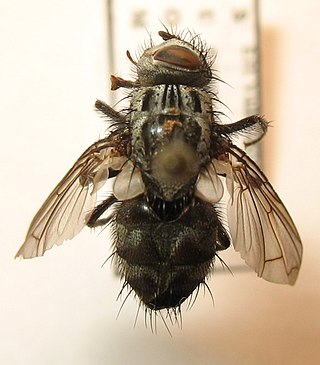
The Tachinidae are a large and variable family of true flies within the insect order Diptera, with more than 8,200 known species and many more to be discovered. Over 1,300 species have been described in North America alone. Insects in this family commonly are called tachinid flies or simply tachinids. As far as is known, they all are protelean parasitoids, or occasionally parasites, of arthropods, usually other insects. The family is known from many habitats in all zoogeographical regions and is especially diverse in South America.
Adejeania brasiliensis is a species of parasitic fly in the family Tachinidae. It is found in South America.

Rutilia is a large genus of medium to large (>20mm) flies in the family Tachinidae native to Australia and the Oriental region, though notably absent from New Zealand. Like the vast majority of tachinid flies, Rutilia species are parasitoids of other insects, specifically Rutilia are known to be parasitoids of late instar larvae of scarab beetles.
Turanogonia is a genus of parasitic flies in the family Tachinidae. There are at least four described species in Turanogonia.

Zelia is a genus of flies in the family Tachinidae. Species in this genus occur exclusively in the Americas.

Dexia is a genus of flies in the family Tachinidae. Most larvae are parasitoids of beetles (Scarabaeidae).

Trichopoda pennipes is a species of feather-legged fly in the dipteran family Tachinidae.

Dexia rustica is a species of fly in the family Tachinidae.

Dinera ferina (Fallen) is a species of fly in the family Tachinidae. In June 2018, the Bulletin of Insectology wrote that Dinera ferina was "confirmed to be a parasitoid of larvae of the two Italian Platycerus species, Platycerus caprea and Platycerus caraboides (L.) ."

Blondeliini is a tribe of parasitic flies in the family Tachinidae. Larvae are parasitoids of other insects, mostly beetles and caterpillars. Although nearly cosmopolitan, its greatest diversity is in the New World and especially in South America.

Eryciini is a tribe of flies in the family Tachinidae

Phasiinae is a subfamily of flies in the family Tachinidae. Except for the small tribe Strongygastrini members of this subfamily attack only Heteroptera.

Phasiini is a tribe of flies in the family Tachinidae. As a result of phylogenetic research, most members of this tribe were transferred to other tribes in the subfamily, leaving only the two genera Elomya and Phasia.

Exorista larvarum is a Palaearctic species of fly in the family Tachinidae.

Compsilura concinnata is a parasitoid native to Europe that was introduced to North America in 1906 to control the population of an exotic forest, univoltine, spongy moth named Lymantria dispar. It is an endoparasitoid of larvae and lives with its host for most of its life. Eventually the parasitoid ends up killing the host and occasionally eating it. It attacks over 200 host species, mainly insects from the Orders: Coleoptera, Lepidoptera and Hymenoptera. Since this parasite has the ability to attack many different types of hosts, the organism has spilled over from the intended forest systems into other areas, like agricultural fields, affecting cabbage pests including the cabbage looper (Trichoplusia); the cabbage worm ; and even other invasive species such as the brown-tail moth. However, it also attacks native, non-pest insects such as the Cecropia moth and American moon moth.

Archytas apicifer is a medium to large sized Nearctic tachinid fly. The species name was authored by the German entomologist Johann Friedrich Jaennicke (1867) and presumably named after the Greek classical philosopher and mathematician Archytas. The larvae are parasites of several caterpillar species.
Clytiomya continua is a European species of fly in the family Tachinidae. Hosts for the parasitoid larvae include Coreus marginatus orientalis, Eurygaster testudinaria, Eurydema gebleri, Eurydema dominulus, Graphosoma rubrolineatum, Homalogonia confusa, and Dolycoris baccarum. Larval development takes six to eleven days.

Phasia pusilla is a European species of fly in the family Tachinidae.

Archytas metallicus is a species of bristle fly in the family Tachinidae. It is found in North America.

Billaea triangulifera is a species of fly in the family Tachinidae. It is a parasitoid of larval Prionus coriarius beetles, piercing the beetle near its spiracles.



















